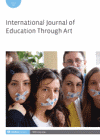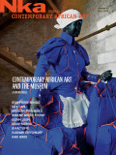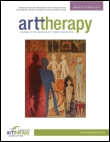
International Journal of Education through Art
Scope & Guideline
Advancing Knowledge at the Intersection of Art and Learning.
Introduction
Aims and Scopes
- Interdisciplinary Approaches to Art Education:
The journal promotes research that integrates various disciplines within art education, encouraging a blend of methodologies from the arts, humanities, and social sciences to enrich educational practices. - Art as a Means of Inquiry:
It emphasizes the use of art as a tool for inquiry and reflection, exploring how artistic practices can facilitate deeper understanding of personal, cultural, and social issues. - Focus on Diverse Artistic Practices:
The journal showcases diverse artistic practices, including visual arts, performance, and crafts, highlighting their role in education and community engagement. - Cultural and Social Contexts of Education:
Research published in the journal often examines the cultural and social contexts in which art education occurs, reflecting on issues of identity, representation, and power dynamics. - Innovative Pedagogical Models:
The journal is committed to exploring and documenting innovative pedagogical models that utilize art to enhance learning outcomes and foster creativity among students.
Trending and Emerging
- Participatory and Community-Based Art Practices:
There is a notable increase in research focusing on participatory art practices that engage communities, reflecting a growing interest in art as a means of social change and empowerment. - Digital and Technology Integration in Art Education:
Emerging themes include the integration of digital technologies in art education, exploring how these tools can enhance creativity and learning experiences for students. - Environmental and Sustainability Themes:
The journal is increasingly addressing environmental issues through art, with a focus on sustainability and ecological consciousness in artistic practices and education. - Decolonial and Anti-Colonial Perspectives:
Recent publications show a rising interest in decolonial and anti-colonial perspectives, examining how art education can address historical injustices and promote inclusivity. - Interdisciplinary Collaborations:
There is a growing trend towards interdisciplinary collaborations within art education, where art is seen as a bridge to other fields, fostering comprehensive educational experiences.
Declining or Waning
- Traditional Techniques in Art Education:
There appears to be a waning focus on traditional techniques and methods in art education, as contemporary practices increasingly emphasize innovation and interdisciplinary approaches. - Art History as a Standalone Subject:
Research centered solely on art history, without connections to contemporary practices or educational methodologies, is becoming less prevalent, suggesting a shift towards more applied and experiential forms of art education. - Focus on Individual Artistic Expression:
The journal has seen a decrease in papers that emphasize individual artistic expression in isolation, as there is a growing trend towards collaborative and community-based art practices.
Similar Journals

ART IN AMERICA
Fostering Dialogue on Visual InnovationART IN AMERICA is a prominent journal dedicated to the exploration and critique of contemporary visual arts and practices within the United States and beyond. Published by BRANT PUBL, INC, the journal serves as an authoritative platform for scholars, artists, and enthusiasts alike, fostering vibrant dialogue and insightful analysis in the field of art. With an ISSN of 0004-3214 and a legacy dating back to 1979, ART IN AMERICA has established itself within the Q4 category of Visual Arts and Performing Arts according to the 2023 category quartiles. Although the journal currently does not offer Open Access options, it remains accessible to a diverse readership through its distribution across libraries and institutions. The journal's significance is underscored by its ability to spotlight emerging trends, critique canonical works, and promote diverse artistic voices amidst a constantly evolving cultural landscape. Researchers, professionals, and students will find ART IN AMERICA not only a valuable resource for scholarly discourse but also an essential guide to understanding the complexities and intricacies of the American art scene.

Journal of Educational Sciences & Psychology
Fostering Scholarly Exchange in Educational Sciences and Psychology.Journal of Educational Sciences & Psychology, a pioneering publication in the fields of education and psychological research, is published by PETROLEUM-GAS UNIVERSITY PLOIESTI. Since its inception in 2011, this open-access journal has fostered scholarly exchange and contributed to the global discourse on educational methodologies, psychological theories, and applied practices. With its ISSN 2247-6377 and E-ISSN 2247-8558, the journal endeavors to provide researchers, professionals, and students with insightful articles that promote innovative approaches to learning and mental health. Despite the absence of specific H-Index or category quartiles, its commitment to high academic standards and accessibility positions the journal as an essential resource for those keen on advancing knowledge within these critical domains. We invite you to explore the diverse range of studies presented in this journal and contribute to its evolving narrative.

Nka-Journal of Contemporary African Art
Illuminating the Intersection of Culture and CreativityNka-Journal of Contemporary African Art is a premier academic publication dedicated to exploring the rich tapestry of contemporary African art and its intersections with culture, society, and identity. Published by DUKE UNIVERSITY PRESS, this journal offers a platform for critical discourse and innovative research within the fields of Visual Arts and Anthropology, earning a commendable ranking in both categories, with a Q2 designation in Visual Arts and Performing Arts. Established in 2019, Nka serves to illuminate the dynamic and evolving narratives of African artists, providing a vital connection for scholars and practitioners engaged with African cultural production. Although currently not open access, the journal aims to foster intellectual engagement and promote inclusivity in the arts, making it an essential resource for those seeking to deepen their understanding of contemporary African artistic practices. With an address based in the heart of Durham, North Carolina, Nka invites contributions from a diverse range of voices to enrich the discourse surrounding contemporary African art.

Art Therapy
Advancing Knowledge at the Intersection of Art and TherapyArt Therapy is a leading academic journal published by ROUTLEDGE JOURNALS, TAYLOR & FRANCIS LTD, dedicated to exploring the intersections of art and therapy since its inception in 1983. As a crucial resource in the fields of Clinical Psychology and Complementary and Manual Therapy, it is positioned in the Q3 quartile for Clinical Psychology and Q2 quartile for Complementary and Manual Therapy based on the 2023 category rankings. With its ISSN 0742-1656 and E-ISSN 2159-9394, the journal continues to be an important platform for researchers, professionals, and students seeking to enhance their understanding of therapeutic practices through artistic expression. Although it is not an Open Access journal, its accessibility through institutional subscriptions ensures a wide dissemination of innovative research and findings. The journal's commitment to advancing knowledge in art therapy makes it a vital addition to any scholarly collection, fostering ongoing dialogue and development in this dynamic field.

Taida Journal of Art History
Unveiling the narratives behind visual and performing arts.Taida Journal of Art History, published by NATIONAL TAIWAN UNIVERSITY, GRADUATE INSTITUTE OF ART, is a pioneering academic journal dedicated to the exploration and critique of art history, particularly within the unique cultural context of Taiwan. Since its inception in 2018, the journal has become an important platform for scholarly discourse, offering insights into the evolution of visual arts and performing arts, alongside comprehensive studies in history. With an ISSN of 1023-2095, it currently ranks within the Q4 category in Arts and Humanities (Miscellaneous) and the Q3 category in History and Visual Arts and Performing Arts, indicating its growing influence in these fields. Researchers, professionals, and students alike can benefit from its rigorous peer-reviewed articles that bridge theoretical frameworks with practical applications, making it an essential resource for those engaged in the arts and humanities. This commitment to fostering academic excellence is reflected in its Scopus rankings, where it stands at Rank #338/667 in Visual Arts and Performing Arts and Rank #1027/1760 in History. Engage with the Taida Journal of Art History to gain deeper insights into the evolving narratives of artistic expression.

Revista Sonda-Investigacion y Docencia en Artes y Letras
Cultivating Collaboration in Creative ResearchRevista Sonda-Investigacion y Docencia en Artes y Letras, published by the ASOCIACION INVESTIGACION, FORMACION CREATIVIDAD, is a pivotal platform for scholars and practitioners in the fields of arts and letters. This esteemed journal, identifiable by its ISSN 2254-6073, seeks to foster a comprehensive understanding of interdisciplinary approaches to the study and teaching of the arts, contributing significantly to the academic discourse in this vibrant domain. With a commitment to open access principles, it enables wider visibility and accessibility of research findings, making significant contributions to the advancement of knowledge in both creative and educational sectors. Although specific metrics like HIndex and impact factor are not detailed, the journal is poised to play a critical role in shaping contemporary artistic education and research within and beyond the borders of Spain, specifically from its base at the Universidad Politécnica de Valencia. By providing a repository for innovative research and pedagogical strategies, *Revista Sonda* appeals to researchers, educators, and students alike, encouraging collaboration and the exchange of ideas that will drive the field forward.

Umeni-Art
Connecting Researchers and Creatives in the ArtsUmeni-Art is a prominent journal in the field of visual arts and performing arts, published by the Institute of Art History, Academy of Sciences, Czech Republic. With its ISSN 0049-5123 and E-ISSN 1804-6509, the journal has established itself as a critical platform for scholarly discourse and artistic expression since its inception in 2002. Although currently classified in Q4 within the Arts and Humanities category, it aims to elevate the understanding and appreciation of the arts through rigorous research and innovative perspectives. The journal's Scopus ranking places it at Rank #573/667, reflecting its growing contribution to the field and expanding reach within the artistic community. With a focus on fostering collaboration among researchers, practitioners, and students, Umeni-Art seeks to enrich the academic landscape with significant findings and discussions that inspire future research and creative endeavors. While it does not offer open access, the journal remains a valuable resource for those vested in exploring the dynamic interplay between art, culture, and society in the contemporary context.

BRAC-Barcelona Research Art Creation
Exploring the Intersection of Art and ScholarshipBRAC-Barcelona Research Art Creation, published by HIPATIA PRESS, is a prominent open access journal dedicated to advancing scholarship in the fields of Visual Arts and Performing Arts. Since its inception in 2013, this journal has become a vital resource for researchers, practitioners, and students, offering a platform for innovative research and critical discourse in art creation. With an impressive impact factor represented by its Q2 ranking in the 2023 category of Visual Arts and Performing Arts, BRAC serves a pivotal role within the academic community, providing essential insights and contributions to the understanding and practice of art in contemporary society. The journal's commitment to open access ensures that significant research findings are readily available to a global audience, fostering interdisciplinary collaborations and the exchange of ideas across borders. As it converges from 2019 to 2024, BRAC continues to elevate artistic research and dialogue, making it an indispensable asset for those invested in the vibrant world of the arts.

Arte Individuo y Sociedad
Transforming Artistic Exploration into Academic Excellence.Arte Individuo y Sociedad, published by UNIV COMPLUTENSE MADRID, SERVICIO PUBLICACIONES, is a leading Open Access journal dedicated to advancing understanding in the realms of Visual Arts and Performing Arts. With an impressive impact factor that places it in the Q1 category of its field and a remarkable Scopus rank of #92 out of 667, this journal stands as a vital resource for scholars, practitioners, and students alike. Since its inception in 1988, the journal has championed the dissemination of innovative research and critical discourse, fostering a platform where creativity and academia intersect. The converged years from 2010 to 2024 signify a dynamic evolution of the journal, reflecting contemporary issues and developments in visual and performing arts. For those interested in exploring the complex interplay between art and society, Arte Individuo y Sociedad offers essential insights and diverse perspectives in an increasingly interconnected global landscape.

GOYA
Fostering Dialogue Among Artists and ScholarsGOYA, published by the esteemed FUNDACION LAZARO GALDIANO, is a pivotal journal in the field of Visual Arts and Performing Arts. With an ISSN of 0017-2715, this Spanish journal serves as a critical platform for scholars, artists, and practitioners to engage with contemporary issues, trends, and methodologies in the arts. Since its inception, GOYA has strived to illuminate the intersection of artistic expression and cultural discourse, with coverage spanning from 2002 to 2024. The journal proudly holds a Q3 category ranking in the 2023 Scopus assessments for its field, reflecting its respected position among peers, with a notable rank of #377 out of 667. Though it does not follow an Open Access model, GOYA continues to contribute significantly to the academic landscape, enabling a deeper understanding of artistic practices and their societal implications. Researchers and students alike will find the journal an invaluable resource for insights and inspiration within the dynamic realm of the arts.